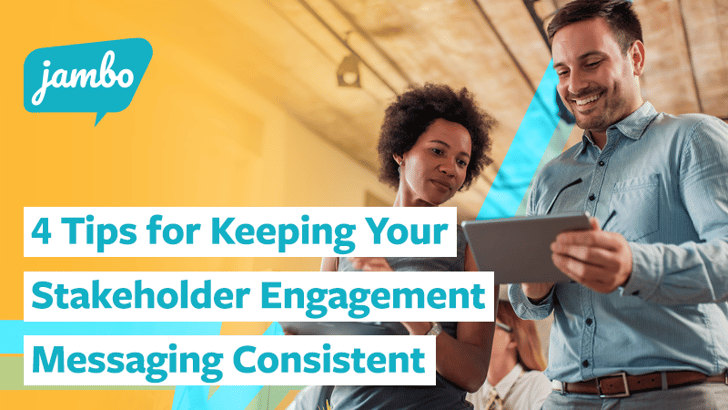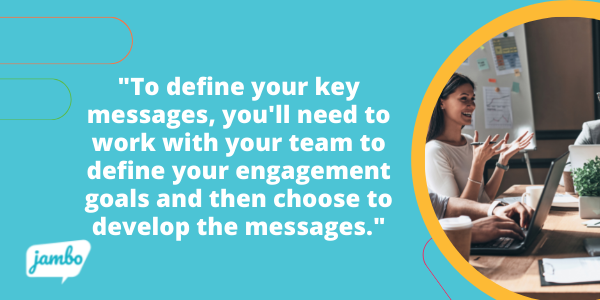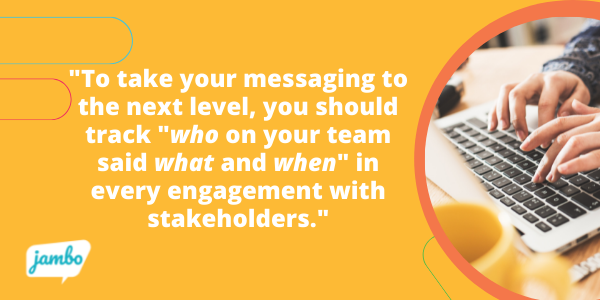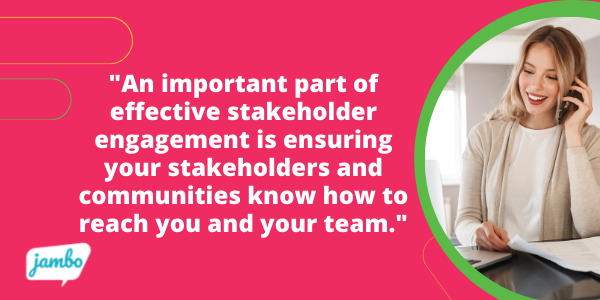
Whether you have multiple stakeholder engagement practitioners on your team, work with engagement contractors, or have one person communicating with everyone, you need to keep your stakeholder engagement messaging consistent across all your communication channels.
Consistent messaging impacts how stakeholders and communities perceive your projects and their overall trust in your organization, whereas mixed messaging can confuse stakeholders and communities and break that vital trust—But how do you keep your messaging consistent?
4 Tips for keeping your stakeholder engagement messaging consistent
1. Develop your key messages early on

As we discussed in our tips for improving how you engage with your stakeholders, you need to develop your key messages early.
To define your key messages, you’ll need to work with your team to define your engagement goals and then choose and develop the messages that will help you reach those goals. Then, everyone from leadership onwards needs to commit to using the selected messages.
Tip: Your stakeholders and communities might not need the same level of communication or even the same messages. To help you decide who you need to engage the most and who might need more in-depth messaging, we suggest conducting a stakeholder mapping exercise with your team.
2. Keep all your stakeholder information logged into Stakeholder Relationship Management (SRM) software, so you can easily track your messaging
Having access to accurate and complete records of all your engagements with your stakeholders and communities will help you easily track of all your messaging to ensure you’re in alignment with your messaging goals.
The best tool for managing your stakeholder engagements and information is Stakeholder Relationship Management (SRM) software. This is software that’s been developed for managing all your stakeholder relationships and communications with your stakeholders.
An SRM ensures your stakeholder information is organized, accessible, searchable and easy to understand so that you can keep track of everything communicated by your teams and your stakeholders. With everything logged and accessible, you always know if your key messages are being used (this can even help you during team planning sessions to identify areas you might need to improve your messaging).
3. Track how your teams are sharing messages with the help of your SRM

To take your messaging to the next level, you should track “who on your team said what and when” in every engagement with stakeholders and communities. This keeps your teams and your stakeholders accountable for everything being communicated and makes it easy to backtrack and see what’s happening in your engagements.
This will help your teams with any stakeholder meetings or touchpoints, as everyone has access to all the messages communicated to each stakeholder. You can then use these records to learn about your stakeholders, understand their perspectives, and decide if your messages are being delivered effectively by you and your teams or if there’s room for improvement.
In an SRM like Jambo, users can simply click into a stakeholder profile before a meeting to gain a quick update on everything that’s been communicated to that stakeholder (and everything that’s been communicated back).
With everything organized, and a clear record of who on the team logged each engagement, you'll always know who to go to with questions. It's also easier to identify opportunities to work with your team to streamline your organization's messaging before the next contact.
With everyone updated and accountable, you can work together more collaboratively to identify gaps in your messaging consistency, opportunities to communicate messages more clearly, and areas for improvement.
4. Make it easy for your stakeholder to communicate with you and your team

An important part of effective stakeholder engagement is ensuring your stakeholders and communities know how to reach you and your team with their perspectives, comments and concerns.
You need this feedback to help you know if you're communicating the right messages. It also allows you to decide when to change your messaging or overall engagement approach.
For example, if your stakeholders are consistently asking specific questions that you thought you’d already answered or bringing up incorrect information about your project, this is an opportunity to alter and strengthen your key messages and offer more consistent and clear messaging.
Expert tips on how to improve your engagements
Successfully delivering consistent messages to your stakeholders and communities will require a team effort. To set your team up for success and help you engage effectively, we developed a free downloadable to share with your team with tips on engaging in today’s world designed with expert advice from Kim Hyshka from Dialogue Partners.
To get your free copy, click the image below!





